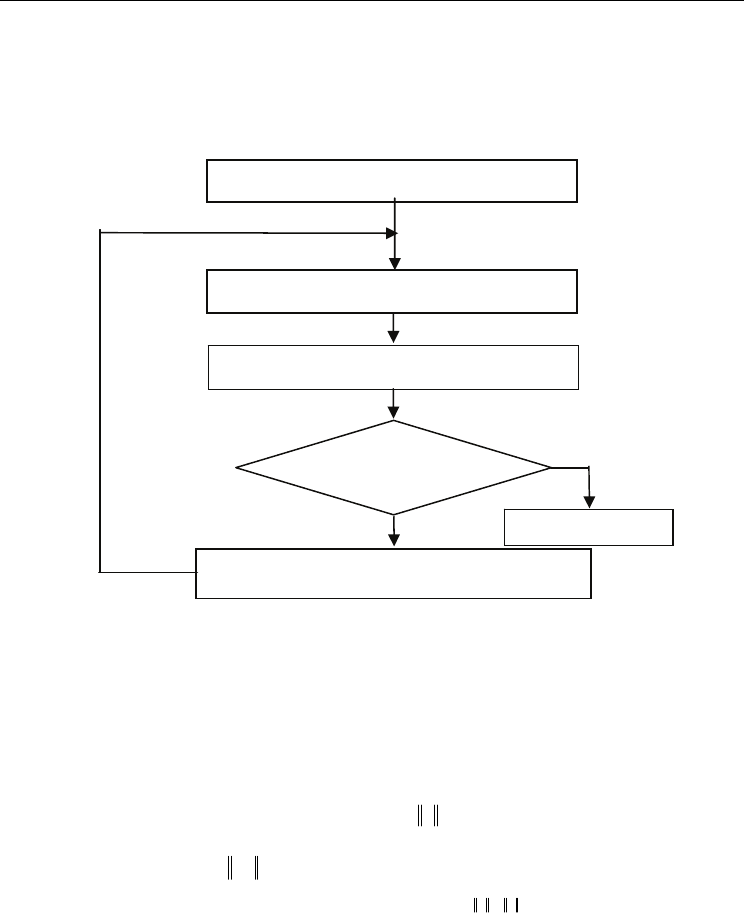Lazinica A. (ed.) Particle Swarm Optimization
Подождите немного. Документ загружается.


Discrete Particle Swarm Optimization Algorithm for Flowshop Scheduling
401
near-optimal solutions (Osman & Laporte, 1996). The fundamental properties which
characterize metaheuristics are as follows (Christian Blum & Andrea Roli, 2003):
• The goal is to efficiently explore the search space in order to find (near-) optimal
solutions.
• Techniques which constitute metaheuristic algorithms range from simple local search
procedures to complex learning processes.
• Metaheuristic algorithms are approximate and usually non-deterministic.
• They may incorporate mechanisms to avoid getting trapped in confined areas of the
search space.
• The basic concepts of metaheuristics permit an abstract level description.
• Metaheuristics are not problem-specific.
• Metaheuristics may make use of domain-specific knowledge in the form of heuristics
that are controlled by the upper level strategy.
• Today’s more advanced metaheuristics use search experience (embodied in some form
of memory) to guide the search.
Metaheuristics or Improvement heuristics are extensively employed by researchers to solve
scheduling problems (Chandrasekaran
et al. 2006; Suresh & Mohanasundaram, 2004; Hisao
Ishibuchi et al. 2003; Lixin Tang & Jiyin Liu, 2002; Eberhart & Kennedy, 1995). Improvement
methods such as Genetic Algorithm (Chan et al. 2005; Ruiz et al. 2004; Sridhar & Rajendran,
1996), Simulated Annealing algorithm (Ogbu & Smith, 1990), Tabu Search algorithm
(Moccellin & Nagamo, 1998) and Particle Swarm Optimization algorithm (Rameshkumar et
al. 2005; Prabhaharan et al. 2005; Faith Tasgetiren et al. 2004) have been widely used by
researchers to solve FSPs. Metaheuristic algorithms such as Simulated Annealing (SA) and
Tabu Search (TS) methods are single point local search procedures where, a single solution
is improved continuously by an improvement procedure. Algorithms such as Genetic
Algorithm (GA), Ant Colony Optimization (ACO) algorithm and Particle Swarm
Optimization (PSO) algorithm belongs to population based search algorithms. These are
designed to maintain a set of solution transiting from a generation to the next. The family of
metaheuristics includes, but is not limited to, GA, SA, ACO, TS, PSO, evolutionary methods,
and their hybrids.
2.4 Performance measures considered
Measures of schedule performance are usually functions of the set of completion times in a
schedule. Performance measures can be classified as regular and non-regular. A regular
measure is one in which the penalty function is non-decreasing in terms of job completion
times. Some examples of regular performance measures are makespan, mean flowtime, total
flowtime, and number of tardy jobs. Performance measures, which are not regular, are
termed non-regular. That is, such measures are not an increasing function with respect to
job completion times. Some examples of non-regular measures are earliness, tardiness, and
completion time variance. In this chapter, the performance measures namely minimization
of makespan, total flowtime and completion time variance is considered for solving
flowshop scheduling problems. Makespan
)C(
max
has been considered by many scheduling
researchers (Ignall & Scharge, 1965; Campbell et al. 1970; Nawaz et al.1983; Framinan et al.
2002; Ruiz & Maroto, 2005). Makespan is defined as the time required for processing all the
jobs or the maximum time required for completing a given set of jobs. Minimization of

Particle Swarm Optimization
402
makespan ensures better utilization of the machines and leads to a high throughput
(Framinan et al. 2002; Ruiz & Maroto, 2005). Makespan is computed using equation (1).
=
max
C
{}
n,........,2,1i,Cmax
i
= (1)
The time spend by a job in the system has been defined as its flow time. Total flowtime is
defined as the sum of completion time of every job or total time taken by all the jobs. Total
flowtime
)F(
∑
of the schedule is computed using equation (2). Minimizing total flowtime
results in minimum work-in-process inventory (Chandrasekharan Rajendran & Hans
Ziegler, 2005).
∑
=
∑
=
n
1i
i
CF (2)
Completion time variance is defined as the variance about the mean flowtime and is
computed using equation (3). Minimizing completion time variance
)(
T
V serves to
minimize variations in resource consumption and utilization (Gowrishankar et al. 2001;
Gajpal & Rajendran, 2006; Viswanath Kumar Ganesan et al.
2006).
∑
=
−=
n
1i
2
iT
)FC(
n
1
V (3)
where
n
F
F
T
=
is the mean flowtime.
3. Particle Swarm Optimization Algorithm
3.1 Features of PSO
Particle Swarm Optimization (PSO) algorithm is an evolutionary computation technique
developed by Eberhart & Kennedy in 1995 inspired by social behavior of bird flocking or
fish schooling. PSO is a stochastic, population-based approach for solving problems
(Kennedy & Eberhart, 1995). It is a kind of swarm intelligence that is based on social-
psychological principles and provides insights into social behavior, as well as contributing
to engineering applications. PSO algorithm has been successfully used to solve many
difficult combinatorial optimization problems. PSO algorithm is problem-independent,
which means little specific knowledge relevant to a given problem is required. All we have
to know is the fitness evaluation of each solution. This advantage makes PSO more robust
than many search algorithms. In the last couple of years the particle swarm optimization
algorithm has reached the level of maturity necessary to be interesting from an engineering
point of view. It is a potent alternative optimizer for complex problems and possesses many
attractive features such as:
•
Ease of implementation: The PSO is implemented with just a few lines of code, using
only basic mathematical operations.
•
Flexibility: Often no major adjustments have to be made when adapting the PSO to a
new problem.
•
Robustness: The solutions of the PSO are almost independent of the initialization of the
swarm. Additionally, very few parameters have to be tuned to obtain quality solutions.

Discrete Particle Swarm Optimization Algorithm for Flowshop Scheduling
403
• Possibility to combine discrete and continuous variables. Although some authors
present this as a special feature of the PSO (Sensarma et al.
, 2002), others point out that
there are potential dangers associated with the relaxation process necessary for
handling the discrete variables (Abido, 2002). Simple round-off calculations may lead to
significant errors.
•
Possibility to easily tune the balance between local and global exploration.
•
Parallelism: The PSO is inherently well suited for parallel computing. The swarm
population can be divided between many processors to reduce computation time.
3.2 Applications of PSO
In recent years, PSO has been successfully applied in many areas. Currently, PSO has been
implemented in a wide range of research areas such as functional optimization, pattern
recognition, neural network training, fuzzy system control etc. and obtained significant
success. PSO is widely applied and focused by researchers due to its profound intelligence
background and simple algorithm structure. Many proposals indicate that PSO is relatively
more capable for global exploration and converges more quickly than many other heuristic
algorithms. It solves a variety of optimization problems in a faster and cheaper way than the
evolutionary algorithms in the early iterations. One of the reasons that PSO is attractive is
that there are very few parameters to adjust. One version, with very slight variation (or none
at all) works well in a wide variety of applications. PSO has been used for approaches that
can be used across a wide rage of applications, as well as for specific applications focused on
a specific requirement. PSO has been applied to the analysis of human tremor. The diagnosis
of human tremor, including Parkinson’s disease and essential tremor, is a very challenging
area. PSO has been used to evolve a neural network that distinguishes between normal
subjects and those with tremor. Inputs to the network are normalized movement amplitudes
obtained from an actigraph system. The method is fast and accurate (Eberhart & Hu, 1999).
While development of computer numerically controlled machine tools has significantly
improved productivity, there operation is far from optimized. None of the methods
previously developed is sufficiently general to be applied in numerous situations with high
accuracy. A new and successful approach involves using artificial neural networks for
process simulation and PSO for multi-dimensional optimization. The application was
implanted using computer-aided design and computer-aided manufacturing (CAD/CAM)
and other standard engineering development tools as the platform (Tandon, 2000). Another
application is the use of particle swarm optimization for reactive power and voltage control
by a Japanese electric utility (Yoshida et al., 1999). PSO has also been used in conjunction
with a back propagation algorithm to train a neural network as a state-of-charge estimator
for a battery pack for electric vehicle use. Determination of the battery pack state of charge is
an important issue in the development of electric and hybrid / electric vehicle technology.
The state of charge is basically the fuel gauge of an electric vehicle. A strategy was
developed to train the neural network based on a combination of particle swarm
optimization and the back propagation algorithm. Finally, one of the most exciting
applications of PSO is that by a major American corporation to ingredient mix optimization.
In this work, “ingredient mix” refers to the mixture of ingredients that are used to grow
production strains of microorganisms that naturally secrete of manufacture something of
interest. Here, PSO was used in parallel with traditional industrial optimization methods.
PSO provided an optimized ingredient mix that provided over twice the fitness as the mix

Particle Swarm Optimization
404
found using traditional methods, at a very different location in ingredient space. PSO was
shown to be robust: the occurrence of an ingredient becoming contaminated hampered the
search for a few iterations but in the end did not result in poor final results. PSO, by its
nature, searched a much larger portion of the problem space than the traditional method.
Generally speaking, particle swarm optimization, like the other evolutionary computation
algorithms, can be applied to solve most optimization problems and problems that can be
converted to optimization problems. Among the application areas with the most potential
are system design, multi-objective optimization, classification, pattern recognition,
biological system modelling, scheduling (planning), signal processing, games, robotic
applications, decision making, simulation and identification. Examples include fuzzy
controller design, job shop scheduling, real time robot path planning, image segmentation,
EEG signal simulation, speaker verification, time-frequency analysis, modelling of the
spread of antibiotic resistance, burn diagnosing, gesture recognition and automatic target
detection, to name a few (Eberhart & Shi, 2001).
3.3 Working of PSO
PSO is initialized with a swarm of random feasible solutions and searches for optima by
updating velocities and positions. PSO algorithm is initialized with a set of several random
particles called a swarm. A set of moving particles (the swarm) is initially thrown inside the
multi-dimensional search space. Each particle is a potential solution, which has the ability to
remember its previous best position and current position, and it survives from generation to
generation. Each particle has the following features:
•
It has a position and a velocity
•
It knows its neighbours, best previous position and objective function value.
•
It remembers its best previous position.
At each time step, the behavior of a given particle is a compromise between three possible
choices
•
To follow its own way
•
To go towards its best previous position
•
To go towards the best neighbour’s best previous position, or forwards the best
neighbour.
The swarm is typically modelled by particles in multi-dimensional space that have a
position and a velocity. These particles fly through hyperspace and have two essential
reasoning capabilities: their memory of their own best position and knowledge of their
neighborhood's best, "best" simply meaning the position with the smallest objective value.
Members of a swarm communicate good positions to each other and adjust their own
position and velocity based on these good positions. PSO shares many similarities with
evolutionary computation techniques such as GA, SA, TS and ACO algorithms. The PSO
system is initialized with a swarm of random solutions and searches for optima by updating
generations. The advantages of PSO are that PSO is easy to implement and there are few
parameters to adjust. PSO has been successfully applied in many areas: function
optimization, artificial neural network training, fuzzy system control, and other areas where
GA can be applied. Most of evolutionary techniques have the following procedure:
1. Random generation of an initial population
2. Reckoning of a fitness value for each subject. It will directly depend on the distance to
the optimum.

Discrete Particle Swarm Optimization Algorithm for Flowshop Scheduling
405
3. Reproduction of the population based on fitness values.
4. If requirements are met, then stop. Otherwise go back to step 2.
Evolutionary Algorithms use a population of potential solutions (points) of the search space.
These solutions (initially randomly generated) are evolved using different specific operators
which are inspired from biology. Through cooperation and competition among the potential
solutions, these techniques often can find near-optimal solutions quickly when applied to
complex optimization problems. There are some similarities between PSO and Evolutionary
Algorithms:
1.
Both techniques use a population (which is called swarm in the PSO case) of solutions
from the search space which are initially random generated;
2.
Solutions belonging to the same population interact with each other during the search
process;
3.
Solutions are evolved using techniques inspired from the real world.
PSO shares many common points with GA. Both algorithms start with a group of a randomly
generated population; both have fitness values to evaluate the population. Both update the
population and search for the optimum with random techniques. Both systems do not
guarantee success. However, PSO does not have genetic operators like crossover and
mutation. Particles update themselves with the internal velocity. The information sharing
mechanism in PSO is significantly different. In GA, chromosomes share information with
each other. So the whole population moves like one group towards an optimal area. In PSO,
only global or local best particle gives out the information to others. It is a one-way
information sharing mechanism. Compared with GA, all the particles tend to converge to the
best solution quickly even in the local version in most cases/ PSO optimization algorithm
uses a set of particles called a swarm, similar to chromosomes in a binary-coded Genetic
Algorithm (GA). PSO and ACO are optimization algorithms based on the behavior of swarms
(birds, fishes) and ants respectfully. However, the particles are multidimensional points in
real space during the optimization. The PSO optimization run starts with a user-specified
swarm size and objective function used to evaluate objection function values, called fitness in
GA terminology. The particles are initialized randomly within the variable bounds and they
search for the optimum (maximum or minimum) in the search space with some
communication between particles. For a maximization (or minimization) problem, the
particles will move towards the particle with the highest (or least) objective function value
using a position update equation, that is stochastic. This is how randomness in introduced to
PSO algorithm. This position update method is similar to the use of crossover and mutation
operations used to generate new individuals in a new generation in the GA. However, the
PSO differs in that, updates of particle position usually involve the best particles (global or in
the neighborhood) of each particle. The position updating tends to always exploit the best
solution found so far. While this may lead to premature convergence, when all particles
positions become equal to that of the best particle (i.e., no diversity), there are schemes
designed to prevent such premature convergence. In the PSO literature, several
neighborhood schemes have been developed for the particle updating (Merkle and
Middendorf, 2000). This chapter aims to develop a metaheuristic algorithm called PSO
algorithm which is suitable for solving FSPs with the objective of minimising three
performance measures namely makespan, total flowtime and completion time variance.
Firstly, a single objective PSO is proposed and the above performance measures are
considered individually. Performance of the proposed single objective PSO is tested by

Particle Swarm Optimization
406
solving a large set of benchmark FSPs available in the literature having number of jobs
varying from 5 to 500 and number of machines from 5 to 20.
3.4 Structure of PSO Algorithm
The pseudo-code of the simple PSO algorithm and its general framework are given in
Figures 3 and 4 respectively.
The basic elements of PSO algorithm are summarized below:
Particle
:
t
i
X denotes the i
th
particle in the swarm at iteration t and is represented by n
number of dimensions as
[
]
t
in
t
2i
t
1i
t
i
x,..,x,xX = , where
t
ij
x is the position value of the i
th
particle with respect to the
j
th
dimension (
n,...,2,1j =
).
Population:
t
pop
is the set of NP particles in the swarm at iteration
t, i.e.,
[
]
t
NP
t
2
t
1
t
X,...,X,Xpop =
.
Sequence: We introduce a new variable
t
i
π
, which is a permutation of jobs implied by the
particle
t
i
X
. It can be described as
[
]
t
in
t
2i
t
1i
t
i
,..,,
ππππ
=
, where
t
ij
π
is the assignment of job j of
the particle
i in the permutation at iteration t.
Figure 3. Pseudocode of the PSO Algorithm
Particle velocity:
t
i
V is the velocity of particle i at iteration t. It can be defined as
[
]
t
in
t
2i
t
1i
t
i
v,...,v,vV = , where
t
ij
v
is the velocity of particle i at iteration t with respect to the j
th
dimension.
Local best:
t
i
P represents the best position of the particle i with the best fitness until
iteration
t, so the best position associated with the best fitness value of the particle i obtained
so far is called the
local best. For each particle in the swarm,
t
i
P can be determined and
updated at each iteration
t. In a minimization problem with the objective function
()
t
i
f
π
where
t
i
π
is the corresponding sequence of particle
t
i
X , the local best
t
i
P of the i
th
particle is
obtained such that
() ( )
1t
i
t
i
ff
−
≤
ππ
where
t
i
π
is the corresponding permutation of local best
t
i
P
Initialize swarm
Initialize velocity
Initialize position
Initialize parameters
Evaluate particles
Find the local best
Find the global best
Do
{
Update velocity
Update position
Evaluate
Update local best
Update global best
} ( until termination)

Discrete Particle Swarm Optimization Algorithm for Flowshop Scheduling
407
and
1t
i
−
π
is the corresponding sequence of local best
1t
i
P
−
. To simplify, we denote the fitness
function of the local best as
()
t
i
pb
i
ff
π
= . For each particle, the local best is defined as
[
]
t
in
t
2i
t
1i
t
i
p,...,p,pP = where
t
ij
p is the position value of the i
th
local best with respect to the j
th
dimension ( n,...,2,1j = ).
`
Figure 4. The Framework of PSO Algorithm
4. Discrete PSO Algorithm for Single-Objective FSP
4.1 Pseudocode of the proposed discrete PSO algorithm
Particle Swarm Optimization algorithm starts with a population of randomly generated initial
solutions called particles (swarm). It is to be noted that the particle structure is taken as a
string, which consists of job numbers in certain order. The order of jobs in the string represents
a sequence. After the swarm is initialized, each potential solution is assigned a velocity
randomly. The length of the velocity of each particle
v is generated randomly between 0 and
n (Rameshkumar et al. 2005; Chandrasekaran et al. 2006) and the corresponding lists of
transpositions
(
)
k
qq
v,1q;j,i = are generated randomly for each particle. The above
formulation permits exchange of jobs
)j,i(......)j,i(),j,i(
vv
2211
in the given order. Each
particle keeps track of its improvement and the best objective function value achieved by the
individual particles so far is stored as local best solution
()
t
k
e
P , and the overall best objective
function achieved by all the particles together so far is stored as the global best solution
).G(
t
b
The particle velocity and position are updated continuously in all iterations. The iterative
improvement process is continued afterwards to further improve the solution quality. The
Pseudocode of the proposed discrete PSO algorithm is shown in Figure 5.
Output the Results
Generate N particles at Random
Evaluate the sequences
Apply Velocity and Move the particle
Update particle Index (P
Current
, P
Best
, G
Best
)
Is the Stopping
Criteria Satisfied?
No
Yes

Particle Swarm Optimization
408
Figure 5. Pseudocode of the Proposed Discrete PSO Algorithm
The particle velocity and position are continuously updated using equation (4) and (5).
)PG()(randUC)PP()(randUCvUCv
1t
kk
33
1t
k
1t
k
e
22
t
k
11
1t
k
++++
−+−+= (4)
1t
k
t
k
1t
k
vPP
++
+=
(5)
where
321
CandC,C is called acceleration constants. The acceleration constants
321
CandC,C in equation (4) guide every particle toward local best and the global best
solution during the search process. Low acceleration value results in walking far from the
target, namely local best and the global best. High value results in premature convergence of
the search process.
4.2 Procedural steps of the Discrete PSO Algorithm
The step by step procedure for implementing the proposed discrete PSO algorithm is as
follows.
Step1: Initialize a swarm
i
P with random positions and velocities in the problem space .X
Step2: For each particle, evaluate the desired optimization fitness function
Step3: Compare the fitness function with its previous best. If current value is better than
previous best, then set previous best equal to current value and
i
P
equal to the
current location
i
X .
Step4: Identify the particle in the neighborhood with the best success so far, and assign its
index to the variable G .
Step5: Apply local search algorithm to all the particles at the end of each iteration and
evaluate for the objective function.
Step6: Change the velocity and position of the particle according to equation (4) and
equation (5).
Step7: Loop to step (2) until a criterion is met (usually number of iterations).
Initialize swarm
P
;0t =
Initialize velocity
t
k
v and position
t
k
P
Initialize parameters
Evaluate particles
Find the local best
t
k
e
P and global best
t
b
G
Do
{
()
N,1k for =
Update Velocity
1t
k
v
+
;
Update Position
1t
k
P
+
;
Evaluate all particles;
Update
1t
k
e
P
+
and
1t
G
+
,
()
N,1k = ;
1tt +→ ;
}
()
max
ttwhile <

Discrete Particle Swarm Optimization Algorithm for Flowshop Scheduling
409
4.3 Numerical Illustrations
An example illustrating the process of updating the velocity and the position of a sequence
is explained as follows:
Velocity update: The procedure for updating the velocity of all the particles in each iteration
is as follows: For example, let us assume
The sequence
t
k
P=
{}
1,4,3,2;
,2C,1C
21
== 2C
3
=
;
3.0U,4.0U,2.0U
321
===
; 2V
k
= ,
)3,2(),4,1(v = ;
t
k
e
P = (1,4,3,2) and
t
b
G = (3,1,4,2) .
Velocity of the particle
k at time step 1t + namely
1t
k
V
+
is obtained using equation (4)
1t
k
V
+
= 1x 0.2 [(1,4),(2,3)] ⊕ 2 x 0.4 [(1,4,3,2) - (2,3,4,1)] ⊕ 2 x 0.3 [(3,1,4,2) - (2,3,4,1)]
where [(1,4,3,2) - (2,3,4,1)] represents a velocity such that applying the resulting
velocity to the current particle (2,3,4,1) yields a position (1,4,3,2).
Thus,
1t
k
V
+
= 0.2 [(1,4), (2,3)] ⊕ 0.8 [(2,3), (1,4)] ⊕ 0.6 [(1,2), (1, 4)]
= ((1, 4),(2, 3),(1, 2))
Position update: Position of the particle k at time step 1t + namely
1t
k
P
+
is obtained using
equation (5) by applying
1t
k
V
+
over
t
k
Pas follows.
1t
k
P
+
=(2,3,4,1) + ((1,4), (2,3),(1,2));
= (1,3,4,2) + ((2,3),(1,2)); =(1,4,3,2) + (1,2);
= (4,1,3,2)
4.4 Performance Comparison
An extensive performance analysis using proposed discrete PSO algorithm is carried out by
means of evaluating the performance measures by solving the benchmark FSPs of Taillard
(1993). Extensive experiments are conducted to fix the parameters like number of particles,
number of iterations, selection of learning coefficients and initial swarm generation. The
evaluation of proposed discrete PSO algorithm is coded in Linux C and run on an Intel
Pentium III 900MHz PC with 128 MB memory.
Number of iterations: Number of iterations or termination criterion is a condition that the
search process will be terminated. It might be a maximum number of iteration or maximum
CPU times are normally to terminate the search process (Liu & Reeves, 2001; Gowrishankar
et al. 2001). In this chapter, for the single-objective optimization problems, an evaluation of
1000 x n x m number of sequences or particles is taken as the termination criterion.
Number of particles: Experiments have been conducted to identify the optimal swarm size
by solving a set of 30 different instances of Taillard (1993) for makespan objective with 20
jobs and machines varying from 5, 10 and 20 using discrete PSO algorithm. In
experimentation, the performance of the algorithm is better with swarm size 80 and the
same has been used throughout our evaluation.
Learning coefficients: The roll of learning coefficients or acceleration constants, namely
21
C,C and
3
C guide every particle towards the local best and the global best solutions
during the search process. Low acceleration value results in walking far from the target,
namely local best and the global best. High value results in premature convergence of the
search process. Experiments have been conducted using different combinations of learning
coefficients. To determine the best combinations of
21
C,C and
3
C values by solving a set of
30 FSPs for makespan objective with 20 jobs and machines varying from 5, 10 and 20 using

Particle Swarm Optimization
410
the proposed PSO algorithm. The values 2C,1C
21
== and 2C
3
= shows better
performance and the same, has been used throughout our study.
Velocity coefficients: The velocity update is carried out after every iteration to improve the
search process. The velocity coefficients, namely
321
UandU,U guides the search to find
the optimal solution quickly. As per the experiments, the values for
321
UandU,U
are
generated randomly between 0 and 1.
Initial Swarm Generation: For the generation of initial swarm one particle is generated from
the results obtained by certain algorithms for the desired optimization fitness function and
remaining particles of the swarm is constructed in a way that a permutation is produced
randomly. The particle generated from certain algorithms is added with randomly generated
particles at the beginning of the search. This insertion of the particle in initial swarm is to find
better sequences in each iteration of the search. And also it improves the performance of
discrete PSO algorithm in terms of finding near-optimal solutions. The algorithms selected for
generating the particle for different objective functions are listed below. For makespan
objective, one particle is generated using NEH heuristic of Nawaz et al. (1983) and is added to
the swarm. For total flowtime objective, one particle is generated based on the heuristic
developed by Rajendran. (1993) and is added to the swarm. For completion time variance
objective, a particle is generated based on the algorithm developed by Gajpal & Rajendran
(2006), and is added to the swarm. These algorithms have better start with the respective
objectives. Performance of the proposed discrete PSO with respect to makespan objective is
carried out in comparison with the benchmark solutions given by Taillard (1993) and with the
results published in the literature. The quality measure namely, “Average Relative Percent
Deviation”
)RPD( is considered for the evaluation. During comparison, the corresponding
better values reported in the literature are taken. The
RPD is computed using equation (6).
100]C/CG[RPD
**
×−= (6)
where, G represents the global best solution obtained by the proposed algorithm for a given
problem and
*
C
represents the upper bound value reported in the literature for the
corresponding objective function. Some sample results of problems ta001-ta010 of Taillard
(1993) is presented in Table 1.
Instances Problem
Results
Reported
Results
Obtained
RPD
ta001 1278 1278 0.0000
ta002 1359 1360 0.0736
ta003 1081 1088 0.6475
ta004 1293 1293 0.0000
ta005 1235 1235 0.0000
ta006 1195 1195 0.0000
ta007 1239 1239 0.0000
ta008 1206 1206 0.0000
ta009 1230 1237 0.5691
ta010 1108 1108 0.0000
20 x 5
RPD
0.1290
Table 1. Sample Results for Makespan
